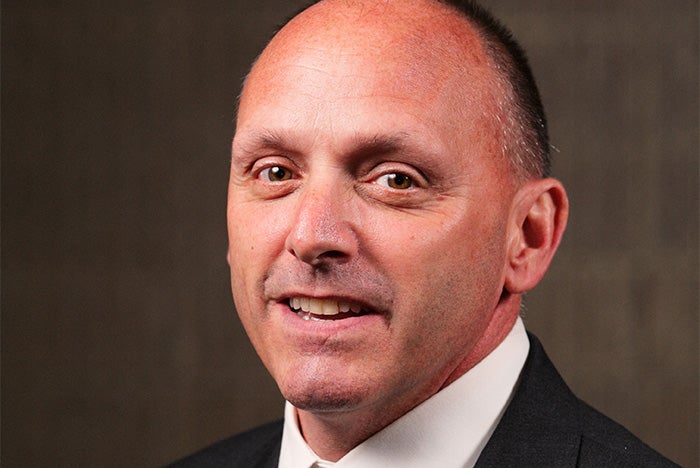Crystal Eagle recipient finds passion in advocacy

The Dagenais File
CV
- Senior director of plant operations, clinical engineering, emergency management and safety officer at Wentworth-Douglass Hospital, Dover, N.H.
- Life Safety Code surveyor at The Joint Commission, Oakbrook Terrace, Ill.
- Director of plant operations, and security and safety officer at Wentworth-Douglass Hospital.
- Manager of plant operations and safety officer at Wentworth-Douglass Hospital.
Affiliations
- American Society for Health Care Engineering (ASHE) 2015 Advisory Board president.
- ASHE advocacy advisory, bylaws task force, faculty, reliability-centered maintenance, education, steering and executive committees.
- National Fire Protection Association’s health care membership section, codes and standards review committee, health care interpretations task force, teaching faculty and technical committee member for standards 99, 101, 110, 730, 731, 25, 70 and 55.
- New England Healthcare Engineers’ Society member.
Education
- Bachelor of Science in business administration, management and operations from Southern New Hampshire University, Dover, N.H.
David A. Dagenais, CHSP, FASHE, senior director of plant operations, clinical engineering, emergency management and safety officer at Wentworth-Douglass Hospital, Dover, N.H., talks about his career and receiving the American Society for Health Care Engineering’s (ASHE’s) 2023 Crystal Eagle Leadership Award.
How did you originally get involved in the health care field?
About 32 years ago, I began to work at my current health care organization. At that point, it was a job that provided consistent work and had opportunity for growth. I learned very quickly that working within the health care environment was very different from working in the contracting world.
I began to feel empowered and that the work I was doing was having an impact on somebody’s well-being. As time went on, I began to understand and learn about all the regulations, requirements and expectations that exist to provide safe, high-quality systems within the care environment.
I needed to be engaged and become more knowledgeable of the process and really change my mindset from being an employee and a worker to someone who impacts the outcomes of patients and uses requirements and codes that make those systems better.
I became involved in the code-making process and, from that point, established a lifelong career in the health care field.
When did you join ASHE, and what are some of the ways you’ve contributed to the organization?
I joined ASHE about 25 years ago. My involvement began at the earliest level of my career in the health care field, simply by attending conferences, gaining knowledge and understanding how the organization operated. I was lucky enough to achieve the Region 1 Emerging Leader Award, and from that point, I was hooked. I began to get involved in committee activities and looked for opportunities to assist the organization and its endeavors.
I was appointed to many National Fire Protection Association (NFPA) committees and still represent ASHE on several today. I also have had the pleasure of serving as the ASHE Advisory Board Region 1 Representative and was lucky enough to serve as the 2015 ASHE president. I have assisted the organization in the development of articles, training programs and currently serve as ASHE faculty. I also serve on the Facility Guidelines Institute’s Health Guidelines Revision Committee. All of this involvement has allowed me to enjoy and expand my career as well as grow as an individual.
How has your involvement in ASHE influenced your career?
As a new health care engineer, I was slightly confused about where I wanted to go and what I wanted to do. As I attended more conferences, the education and collaboration at the national level and within the chapters helped me realize that this was an organization that was going to help me choose my destiny.
I found my passion in the codes development process and the advocacy efforts that ASHE was involved in. I learned early that it makes more sense to get involved in the advocacy and code development process rather than just waiting for these requirements to be handed down. ASHE gave me the tools, resources and opportunity to help craft and change codes and standards so that we can provide better outcomes for our patients and eliminate unnecessary tasks that have no value.
That is really where my career began to launch and, from that point forward, I have enjoyed the opportunities ASHE has given me to get involved in code development, advocacy and training. Access to all these resources from ASHE allowed me to grow within my own organization as I became the content expert at my facility and within my system.
What are some ways you’ve seen ASHE evolve over the years?
When I first joined the organization, there was a tremendous amount of focus and content around the mechanical side of facilities management, such as how to operate boilers, how to operate generators and those types of things that are essential. The field then shifted and began to demand greater skills from individuals in facilities positions.
The core skills were still integral, but there was also an expectation that facilities managers could run the business side, too. ASHE recognized that it really developed this philosophy we’ve heard many times: “boiler room to boardroom.” ASHE began to develop tools that managers could use to elevate their knowledge base and speak using the same language as the C-suite.
Later in my career, the field shifted again with a focus on reducing energy costs. ASHE again quickly evolved, continuing to provide support for the built environment, but finding ways to do so in a more cost-effective manner that was better for the environment. Programs like Energy to Care® and other sustainability initiatives were developed.
On the codes and standards front, every time a new code came out it just added additional requirements, sometimes even conflicting with other codes. ASHE quickly realized codes and standards should have a specific purpose and connect to better outcomes for patients. Through advocacy efforts, ASHE has become a front-runner in developing codes that produce better outcomes, utilizing studies and data to ensure that if a new code is passed, it has a direct correlation to the safety or outcomes of our patients.
What are some of the major changes you’ve seen in the health facilities management field?
Nowadays, there is truly an expectation that health care facilities managers run their departments as if they are businesses based on productivity, outcomes and strategic initiatives. Strategies like benchmarking are essential to the success of facilities managers.
Facilities managers are being asked to interact across multiple departments as they develop strategies to reduce costs and expenses as well as carbon footprints. Many of them not only manage the facilities side, but they may also be managing other departments, which requires them to have stronger business skills, soft skills and be better leaders. Knowledge of planning, design and construction has also changed over time; in many cases, organizations are choosing not to have a separate construction division.
The expectation from executive leaders is that the areas of environment of care and life safety perform well during the accreditation process. Soon, we’re also going to see requirements with a greater emphasis on reducing carbon footprints, and our leaders will expect us to accomplish this in our organizations, too.
What advice or encouragement would you give those entering the field who would like to be in leadership one day?
The best advice I can give would be to get involved. The process of getting involved opened doors and opportunities that I could never have imagined. Seek out all the information that ASHE has to offer, and get involved in committees and codes development activities. Use all the assets that ASHE offers to excel in your organization and become a leader that the health care field is demanding in its current environment. We can choose our destiny and craft what the future of health care engineering looks like.
Michael Hrickiewicz is editor-in-chief of Health Facilities Management magazine.




